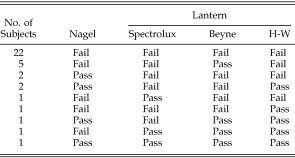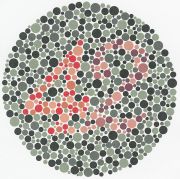“Can I become a police officer even when I’m colorblind?” This is a common question among colorblind young men, when dreaming about a career at the police department.
This article will tell you, if color blindness really matters when you want to become a police officer. First we will have a look at some main factors and possible test methods. After that you will find out more about local regulations concerning color vision and some actual job offers seeking police officers. An in the last part of this article I will list your 6 steps you have to walk through to become a police officer despite your color blindness—or at least to make sure you check all your possibilities.
Imagine the following situation: A police officers witnesses a theft and reports it to the police station. “The suspect is about 35 years old, has brown, dark-brown, no black hair. A orange, I mean green shirt; or was it yellow-red. And blue, almost blue, kind of blue trousers. Skin color—oh don’t care about.” I know, it doesn’t have to be like that if you suffer a mild color blindness. But with some types of severe color vision deficiency this statements are coming closer to the truth than not.
Color blindness is not a definite no go for becoming a police officer, but it’s certainly a big handicap. Before we have a closer look at the topic and the differences in some countries and police departments, you might like to read this story of a colorblind police officer and his personal career.
If you are suffering from some kind of color vision deficiency and want to become a police officer, there are several factors to be considered.
- Type of color blindness. There are different types of color blindness. The strongest form is called achromatopsia, whereas you can only see in shades of gray. This would certainly disqualify you from being a police officer. For the other types like red-green and blue-yellow color blindness it mostly depends on the factor listed next.
- Severity of color blindness. Is it only a mild form of color blindness or are you a dichromat, who have only two different color receptors compared to three with normal vision? Mild forms of color blindness are often not even recognized by the person concerned. Only by taking some tests, they’ll find out about it. It definitely depends on the severity of your color vision deficiency, to make a judgment about your fitness to be a police officer.
- Local recruitment regulations. Different countries, states, cities or police departments have sometimes different recruitment regulations. Most often this includes also some restrictions concerning color vision ability. Check your applicable regulations.
- Recruiting staff. And last but not least, it depends either on the person who is recruiting you or on your new boss. In the end they will decide, if you are the right person for this job or not. Maybe if you just fit in, they will bend the rules to your advantage.
If you apply for the job as a police officer, this will almost ever include any form of color vision test. Most often this is done with an Ishihara plates test, but also Farnsworth tests and City University tests are in use to test your eye sight concerning color blindness.
Often people say, they just cheat on those tests and that will do it. I think, this isn’t the way to go. What, if they find out afterwards, or you annoy your partner because you can’t see the colors you should? And what if they will find out during the test, because cheating isn’t always easily done? I recommend to just be yourself. If it is the right job for you, you will find your way with legal methods.
I would like to point out some regulations and job offers I found. You will see, that there are different wordings used when talking about color vision ability and it’s not always obvious what it really means.
Color Vision Deficiency Regulations for Police Officers
To start with I would like to point out this story of a colorblind police officer applicant written down by a chief of the Berkley police department. It shows very nicely, that it’s not always easy to make a judgment and that there are possibilities even for somebody with a color vision deficiency.
In the United States, the New York State Police writes in their qualifications notes, that color blindness is disqualifying. The Washington State Patrol Trooper formulate it with ability to distinguish colors and be free of color blindness and night blindness. A bit less restrictive is the formulation used for recruiting at the Los Angeles Police Department: Candidates must be able to accurately and quickly name colors. A whole battery of tests has the City of Falls Church requiring that Candidates must pass near vision, color blindness, darkness perception, night vision, and peripheral vision tests. And on the other side we have the very concise formulation NO color blindness of the Portsmouth Police Department.
If you jump over the Atlantic Ocean and have a look at some regulations concerning the recruitment of police officers in the United Kingdom, it looks a bit different. According to policies of the Police Service of Northern Irland, an applicant must have 7 out of 10 correct replies in the City University Colour Vision Test. The detailed eligibility requirements for color vision of England and Wales read as follows:
Monochromats should be rejected. Mild anormalous trichromats are acceptable and should be treated as normals. Severe anomalous trichromats and dichromats are also acceptable but should be instructed in coping strategies.
Whereas color vision should be tested with the Farnsworth D-15 test and applicants should not wear ‘color correcting’ lenses during the color test (eyesight standards for police recruitment). A similar wording is used in the eligibility notes of the British Transport Police.
As the last station, we have a look at Switzerland, the country I’m living in. The regulations I found are the most fuzziest ones. The Kantonspolizei Zürich is looking for people with some Farbwahrnehmungsfähigkeit (ability of color perception) and the Kantonspolizei St.Gallen states that aspirants must have in der Praxis ungestörte Farbwahrnehmungsfähigkeit (undisturbed ability of color perception in practice). This is free to interpretation.
Police Officers Job Offers
Looking at some actual job offers for police officers, you will find some similar or even stronger wordings as in the regulations mentioned above. The City of Manteca expects you to be free from significant color blindness and also the City of Pasadena states explicitly, that you have to be free from color blindness. Compared to this the formulation chosen by the City of Ames sounds a bit less restrictive: Vision cannot be inhibited by color blindness or night blindness.
But anyway, job offers seeking a police officer are most often including one of the wordings above and sound very restrictive. Don’t be intimidated by those formulations. Of course everybody is always looking for the perfect match in a job offer. But if color blindness is your only disadvantage you might find your way through anyway.
Your 6 Steps
Recapitulating the facts listed above about regulations and job offers, you have to conclude that color blindness does really matter when you try to apply for an employment as a police officer. With a severe color blindness there is only a little chance to be employed. On the other side with a mild form of color vision deficiency, you might have some chances. Specially in the UK, where the regulations are the most liberal, you could make your way.
Let’s go back to our initial question, if you can become a police officer when suffering some type of color vision deficiency. As we learned, the answer is neither yes nor no. It’s something in between. And becaus you not just give up but keep trying hard to accomplish what you are aiming for, I list six steps you have to take to become a police officer despite your color blindness.
- First of all you have to check the severity of your color vision deficiency. This can be done either superficial with some online color blindness tests or thoroughly at your local eye specialist. If you suffer from a strong form like complete red-blindness, it will get quite tough for you to find a job as police officer. So this first step should help you to plumb your chances of success.
- After that you should try to find the eligibility notes of your chosen future employer concerning color vision. There are many different nuances in the regulations and they will give you some idea, what they demand. For example the LAPD is much more liberal than some other police departments.
- Before you apply you might ask, if color correcting lenses are applicable. There is a possibility of buying some lenses, which can help you to better distinguish certain colors. They don’t make you see more colors, but help to see some differences you can’t see without them. Some police departments might allow you to wear such color correcting lenses. Don’t hesitate to ask them.
- If you’ve taken the first hurdle of the employment process, you almost certainly will have to pass a color vision test. Take the test as good as you can without cheating. This will show them the truth about your color vision abilities and of course will be the basis for their decision making. If your application will be denied, try to find out the reason behind it. Maybe it’s not only your color blindness but also some other aspects. And if it is only because you’re colorblind, try to find out more about it; why they won’t employ you. This will help you to get a better understanding, if your type of color blindness is a barrier or not in your job life as a police officer.
- Failed the first time? Don’t be disappointed. You might try different police departments where you can apply as an officer. This will take you back to point #2 of this six steps list. And because regulations can be so different, there is most often a chance at another place to get the job you want. Only if you applied for more than one job you can say, that you did everything to make your dream become true.
- And if the first five steps didn’t help you to become a police officer, why not start with an other job in the police department and go on from there. There are not only police officers working at a police department. You might find another job you can start with and make your own way. If you are inside the system, usually some more opportunities will open up for you. So don’t hesitate to build your own personal career.
An to answer the starting question: YES, you can become a police officer even if you are suffering some form of color vision deficiency. BUT the way might not be the easiest one and it definitely won’t become true for some of you who are severely colorblind.



